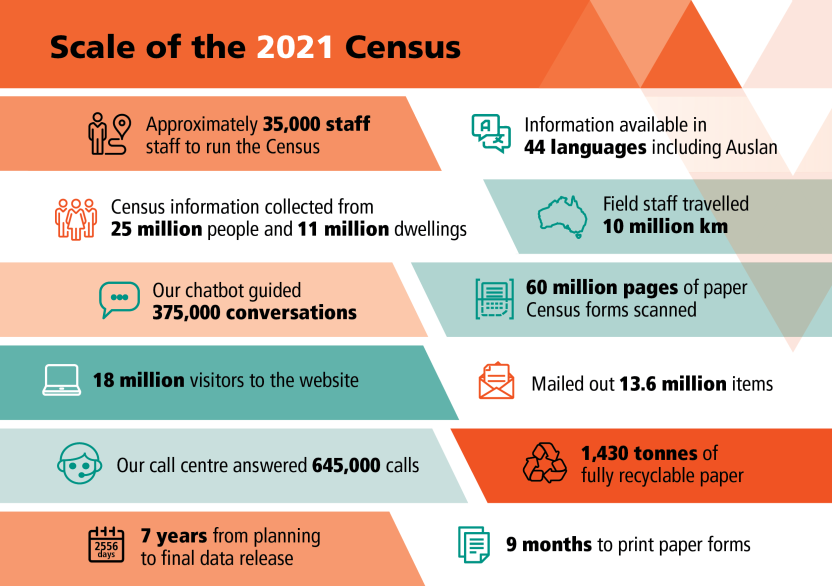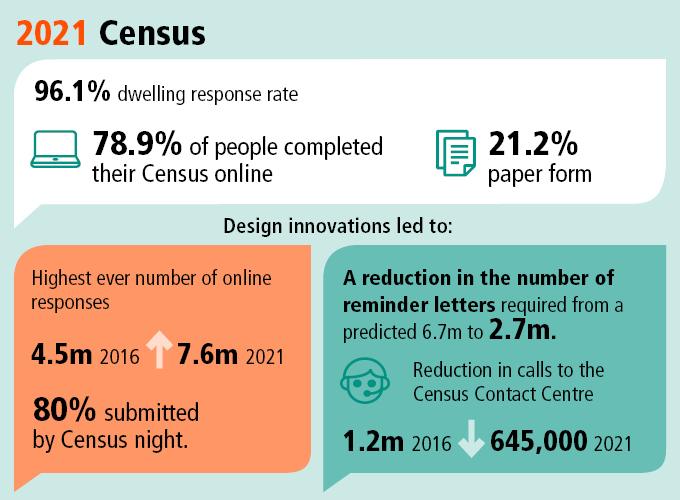The 2021 Census stories
Timeline
To reach every person who is in Australia on Census day, and ensure we count every dwelling, the ABS needs at least six years for planning and coordination. The diagram below shows the stages involved in moving towards operations and preparedness for the 2021 Census.
Image
Description
Preparations for the 2021 Census start before the last one has been conducted and in the year after the 2016 Census, initiation for the 2021 Census program was well underway.
In order to ensure systems and processes are robust, we undertake testing, and in the lead up to the 2021 Census we ran two major tests. In 2019, we engaged 40,000 dwellings in Queensland and New South Wales to test our new:
- field management structure
- recruitment process
- Census questions.
In 2020, we engaged 100,000 dwellings in parts of New South Wales, the Australian Capital Territory, South Australia, Western Australia and the Northern Territory to test our:
- COVID strategy
- digital service
- processing and coding systems
- Remote Area Strategy.
The Census collection period starts at the beginning of a Census year with the recruitment of engagement staff, who contact communities and larger establishments such as hospitals and hotels. This preparation is important for raising awareness of, and sharing procedures for, the upcoming Census. In July a communications campaign begins, a contact centre opens and a website is launched. In the lead up to Census day, typically one to two weeks before, materials are sent to households through the post or, where mail is less reliable, delivered by field staff. These materials explain how to participate and encourage people to respond either online or using a paper form.
After Census day, field staff visit dwellings that have not responded to remind them to complete the Census. Field staff also visit establishments (like hotels) to collect any forms left there.
After the Collection period, we spend 10 months processing the responses before delivering the data. The 2021 Census data is being delivered in a phased approach with three releases: the first on 28 June 2022, the second on 12 October 2022, and the third in March 2023.
Image
Description
Staffing profile
The ABS employed 35,000 temporary and ongoing staff to work on the 2021 Census. This included:
- 33,000 temporary field staff across the country
- 400 temporary field support staff centrally managing the field operations
- 800 temporary staff within our Data Capture Centre and data operations centre to process all the paper forms and code all the responses
- 800 ABS office staff including those in the Census Program, and in technology, human resources and office support.
This number does not include some large workforces involved in the Census through our external vendors including:
- Australia Post to deliver and return letters and paper forms
- establishment officers (up to 10,000) to deliver and collect forms at large establishments like hospitals and hotels
- logistics providers such as printing, materials handling and transport companies
- human resources suppliers working to recruit and pay our temporary staff
- the Services Australia Contact Centre (peaking at 3,500 operators) to receive calls from the Australian public
- our major IT partners – PwC Australia and Amazon Web Services
- another 40 suppliers and their staff.
Scale of the Census
The scale of everything in the Australian Census is large, including the workforce, the materials and the engagement with everyone living in Australia on Census day. Below are a few examples.
Image

Description
Learning from the 2016 Census
The 2016 Census provided many important insights and lessons. A number of reviews were conducted into the 2016 Census, primarily because of the high-profile 40-hour website outage, but there were also other concerns about privacy and communication. These reviews included a report the Australian Government commissioned by Alastair MacGibbon, Review of the events surrounding the 2016 eCensus, and a review through the Australian Senate, 2016 Census: Issues of trust. We also commissioned our own review into the data quality of the 2016 Census by the Independent Assurance Panel, Report on the quality of 2016 Census data.
We combined the recommendations from these reviews with the findings of our own internal evaluation and a review of other international census experiences. This resulted in the following key lessons on how we should prepare for, and conduct the 2021 Census:
- Improve risk management and risk mitigation.
- Seek more external expertise and assurance.
- Be cautious of past successes.
- Plan for things to go wrong.
- Be attuned to changing contexts and be respondent focused.
- Improve communication and engagement.
- Have trust in the public to do the right thing.
- Understand that perceptions are as important as reality.
- Plan for the possible, not just the expected.
You can also read our actions from the MacGibbon recommendations on the ABS website.
We were keen to meet public expectations for a modern experience in conducting the 2021 Census. We wanted to provide respondents with a simple, streamlined service and remove any barriers they had to completing a Census form.
The stories in this report describe some of our major initiatives and how we succeeded in implementing what we learned from 2016. The initial Census data was released on 28 June 2022 and we can proudly claim we:
- achieved a very high response rate
- achieved a high-quality statistical outcome
- provided an improved experience for the public and our staff compared to 2016.
Image
